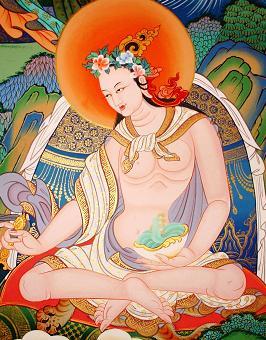Yeshe Tsogyel — the principal consort of Mahaguru Padmasambhava or Guru Rinpoche. She is revered throughout the Himalayas and is often referred to as “Mother Yeshe Tsogyel”, the queen of the ḍākinīs. She is said to be Vajravarahi in human form and well as the emanation of Tara and of Buddhalochana. In one biography, Guru Rinpoche himself referred to her as the incarnation of the goddess Sarasvati who would help him to propagate the Vajrayana teachings.
Sources for the life of Yeshe Tsogyel provide varied interpretations and some inconsistencies regarding her biography. However, the consensus seems to be that she was born in a bird year in the eighth century in the valley of Drak in Tibet. Her best-known biography, written in the 17th century by Taksham Nuden Dorje recounts her birth as a princess of the Kharchen clan. Other biographies offer different accounts of her parentage, but Tibetans ofter refer to her as the “Princess of Kharchen”.
The 12th century master Nyangrel Nyima Ozer revealed the terma that became the most well-known biography of Guru Rinpoche, known as The Copper Palace (bka’ thang zangs gling ma). Yeshe Tsogyel is named as the author of the text. In that text, she records that she was sixteen when the master took her as a spiritual consort to practice at Chimpu cave above Samye monastery. In The Copper Palace manuscript, she is not described as a consort of Emperor Trisong Detsen, but in other accounts she is specifically mentioned as one of his queens. In those accounts, the emperor offered her to Padmasambhava as a mandala offering.
When Padmasambhava initiated his heart disciples, Yeshe Tsogyel received the Vajrakīla transmission. Vajrakīla literature from the same period mentions that Karchen Za Tsogyel held the transmission of the Kīla teachings. It was through this practice that she was said to have attained accomplishment.
According to The Copper Palace, Yeshe Tsogyel obtained the power of perfect memory, enabling her to record all the teachings she heard. Her role in concealing these as terma treasures to be revealed at the appropriate time makes her instrumental in the development of Buddhism in Tibet and thereby conceal them as treasure for later generations. At the end of her life, after giving her final teachings, she is said to have flown directly to Zandok Palri, the Copper-colored mountain.
Yeshe Tsogyel’s preeminence in preserving and concealing treasures throughout Tibet was summarized in her own words, in a terma attributed to Gyalwa Jangchub:
Not a single clod of earth that hands may grasp
Is now without by blessing.
And time the truth of this will show–
The proof will be the taking out of Treasures…
The fivefold elements I brought beneath my say,
And everywhere, I filled the earth with Treasures.
Chokgyur Lingpa wrote a moving verse of supplication to Guru Rinpoche and Ḍākinī Yeshe Tsogyel that underlines their perfect union,
Embodiment of all victors, Guru Padmasambhava,
Holder of discriminating knowledge, Mother Yeshe Tsogyel,
Indivisible vidyādharas, Lord and Lady gurus,
I supplicate you! Bestow your blessings on me!
Practitioners may wish to read the inspiring aspiration prayer for rebirth in the Copper-Colored Mountain penned by this nirmanakaya.
The Goodman Lecture: Being Human and a Buddha Too: Dialogues with Yeshe Tsogyal



